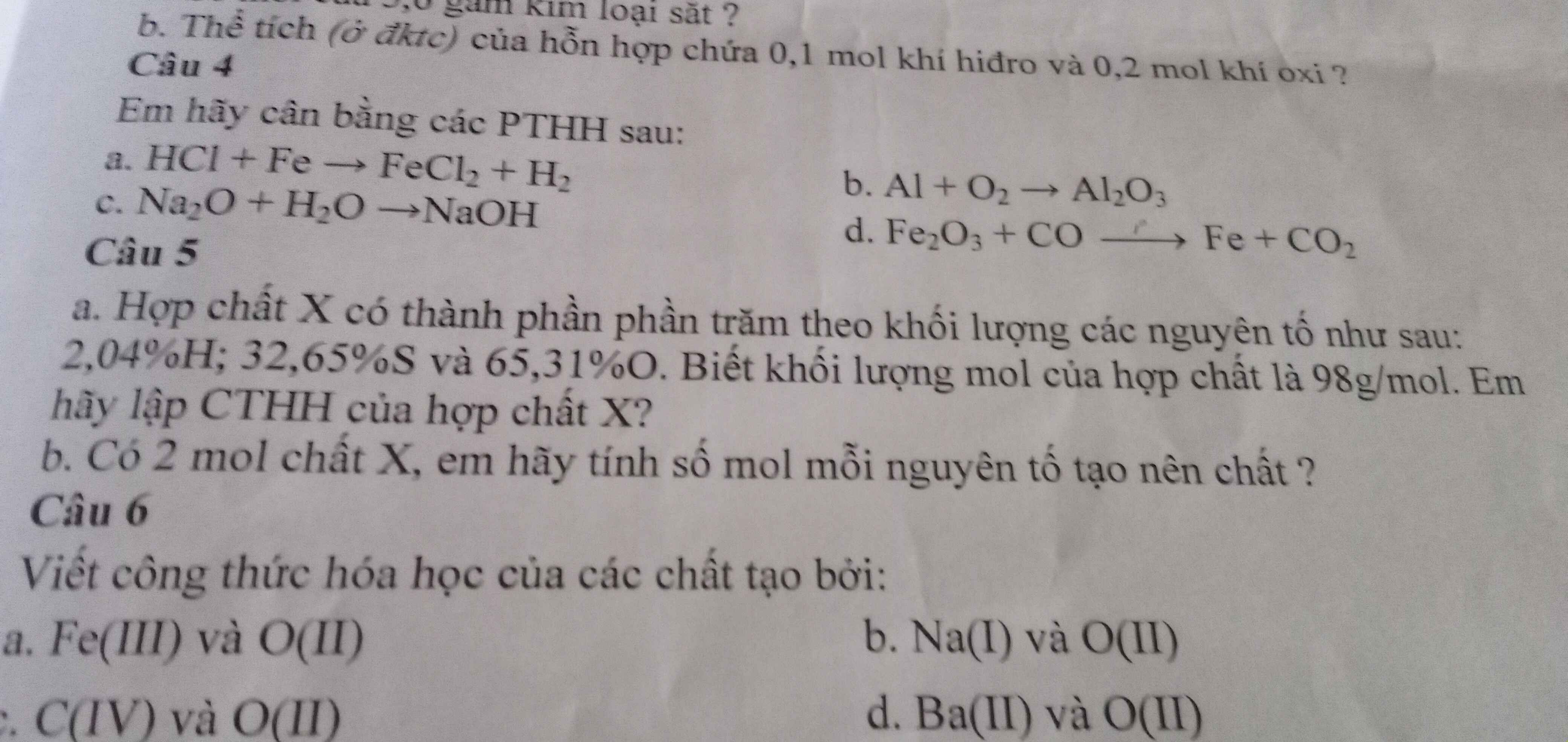
Hãy nhập câu hỏi của bạn vào đây, nếu là tài khoản VIP, bạn sẽ được ưu tiên trả lời.


BT4: Hiệu suất phản ứng:
\(H=\dfrac{m_{tt}}{m_{lt}}.100\%=\dfrac{36,48}{48}.100\%=76\%\)
BT5 Khối lượng đồng thu được:
\(H=\dfrac{m_{tt}}{m_{lt}}.100\%\Rightarrow m_{tt}=\dfrac{m_{lt}.H}{100\%}=\dfrac{48.95}{100\%}=45,6\left(g\right)\)

Ta có: mNaCl = 300.20% = 60 (g)
⇒ mH2O = m dd NaCl - mNaCl = 300 - 60 = 240 (g)
Đáp án: D

a)
\(m_H=\dfrac{2,04.98}{100}=2\left(g\right)=>n_H=\dfrac{2}{1}=2\left(mol\right)\)
\(m_S=\dfrac{32,65.98}{100}=32\left(g\right)\) => \(n_S=\dfrac{32}{32}=1\left(mol\right)\)
\(m_O=\dfrac{65,31.98}{100}=64\left(g\right)=>n_O=\dfrac{64}{16}=4\left(mol\right)\)
=> CTHH: H2SO4
b)
nH = 2.2 = 4(mol)
nS = 1.2 = 2(mol)
nO = 4.2 = 8 (mol)

\(n_{Mg}=\dfrac{1,2}{24}=0,05\left(mol\right)\\
pthh:Mg+2HCl\rightarrow MgCl_2+H_2\)
0,05 0,05
\(n_{CuO}=\dfrac{8}{80}=0,1\left(mol\right)\)
\(pthh:CuO+H_2\underrightarrow{t^o}Cu+H_2O\)
\(LTL:0,1>0,05\)
=> CuO dư
theo pthh: \(n_{CuO\left(p\text{ư}\right)}=n_{Cu}=n_{H_2}=0,05\left(mol\right)\)
\(\Rightarrow m_{Cu}=0,05.64=3,2\left(g\right)\)
\(\Rightarrow m_{CuO\left(d\right)}=\left(0,1-0,05\right).80=4\left(g\right)\)

\(a) Zn + H_2SO_4 \to ZnSO_4 + H_2\\ b) n_{H_2} = n_{Zn} = \dfrac{97,5}{65} = 1,5(mol)\\ V_{H_2} = 1,5.22,4= 33,6(lít)\\ c) n_{Fe_2O_3} = \dfrac{120}{160} = 0,75(mol)\\ Fe_2O_3 + 3H_2 \xrightarrow{t^o} 2Fe + 3H_2O\\ \dfrac{n_{Fe_2O_3}}{1} = 0,75 > \dfrac{n_{H_2}}{3} = 0,5 \to Fe_2O_3\ dư\\ n_{Fe_2O_3\ pư} = \dfrac{n_{H_2}}{3} = 0,5(mol)\\ \Rightarrow m_{Fe_2O_3\ dư} = 120 - 0,5.160 = 40(gam)\)

\(n_{H_2}=\dfrac{0,224}{22,4}=0,01\left(mol\right)\\
pthh:2R+2H_2O\rightarrow2ROH+H_2\)
0,02 0,01 (mol)
\(\Rightarrow M_R=0,78:0,02=39\left(\dfrac{g}{mol}\right)\)
mà R hóa trị I => R là K

vì đây là pứ với chất oxi hóa mạnh và có nhiệt độ cao nên P phải nên hóa trị cao nhất nhé , muốn P lên hóa trị 3 cần cho oxi thiếu thì sẽ đc nha






